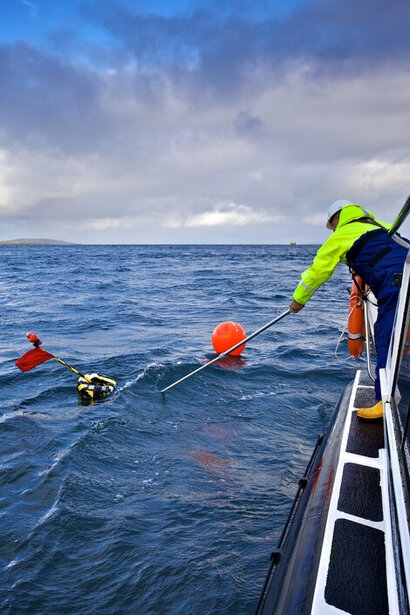
This summer, EMEC will deploy a series of acoustic surveys designed to monitor noise levels of marine energy technologies at its ocean energy test sites in Orkney, Scotland.
The acoustic survey programme will attempt to monitor:
wave energy converters demonstrated by Mocean Energy and AWS Ocean Energy at EMEC’s Scapa Flow scale wave energy test site, via the European Maritime and Fisheries Fund (EMFF) SEA Wave project;
and
tidal energy technologies demonstrated by Orbital Marine Power and Magallanes Renovables at EMEC’s Fall of Warness tidal energy site, funded by Horizon 2020 projects, FloTEC and MaRINET2.
EMEC will deploy static and drifting hydrophones (underwater microphones) to characterise the acoustic signature of devices during operation. The data will be compared to baseline data collected prior to technologies being present on site, allowing developers to build an acoustic characterisation of their technology.
Marine mammals use a wide band of acoustic frequencies to navigate and communicate. As the ocean energy sector is still in development, it is necessary to establish whether exposure to noise from technologies could result in behavioural changes such as displacement from key habitats, or disturbance at breeding, foraging or social sites.
By measuring the acoustic noise of renewable devices, EMEC, developers and regulators can better understand what noise is emitted, any potential impacts on marine life, and consider mitigations, as necessary. This in turn should ease future permitting of devices as regulators also gain a better understanding of the impact of ocean energy on the environment.
“EMEC is at the forefront of monitoring and collecting data for environmental assessments for wave and tidal energy” said Donald Leaver, Environment & Consents Officer at EMEC. “The sector is determined to find new renewable energy solutions to help combat climate change so it’s vital that we understand how new technologies may impact marine life to mitigate any potential impacts. Acoustic monitoring will also give confidence to regulators when consenting technologies supporting the continued development of the sector.”
For additional information:

